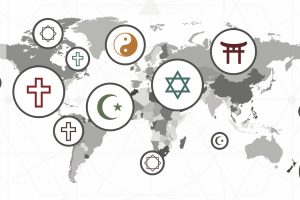
Traditionally a country with strong ties to the Catholic Church, the religious landscape of the Republic of Ireland is becoming more diverse and even secular, which many attribute to church scandals, an increasing immigrant population and the country’s economic prosperity.
The modern trend of people moving away from the Catholic Church is believed by many to be closely linked to a number of high profile scandals in the Church.
“Many people are unhappy with the scandals and abuses of power in religion, particularly with the Catholic Church. Also, more people are less interested in institutional religious practice, inasmuch as it doesn’t address their actual lives and concerns,” said Dr. Michael George, chair of the Religious Studies Department at Saint Mary’s University in Nova Scotia, Canada.

© Rodrigo Garrido | Shutterstock.com
Imam Ibrahim Noonan, an Irish-born convert to Islam Ahmadiyyat, agrees that the decline of the Catholic Church is closely connected to decades of abuse by its clergy, uncovered in the mid-1990s.
“The abuse just shattered the Irish people in the Roman Catholic Church. I know many of my own family members that are still Catholics, my parents, my brothers and sisters. They believe in God and they want to believe in God, they believe in Jesusas and they want to believe in Jesusas but they just don’t want to be part of the Catholic Church. They are in a very difficult position because they want to remain Catholic but without the Church,” he said.
According to the 2011 census, the number of Catholics in Ireland dropped to 84.2 percent. On the other hand, the percentage of those who don’t associate with a religion, atheists and agonistics, has increased nearly 4 times since 1991 to a total of 277,237.
The decrease in Catholic followers has also been attributed to materialism. It has been suggested that as people moved away from religion, they gained economic prosperity.
Imam Noonan thinks that the decline of religion can be heavily attributed to Ireland’s great economic prosperity in the 1990s, known as the Celtic Tiger, which lasted from 1995 to 2007. The country’s transition from an underdeveloped country to a thriving one created a culture of materialism leading people away from religion according to Noonan.
“Materialism became a big thing and during that period a lot of people moved away from the belief in God. They were more concerned with earning a lot of money and having big houses, cars, holidays and enjoying life to the full. That would be why one generation went away from the practice of religion,” said Noonan.
Though the Church has lost many adherents, strong traces of Catholicism can still be found in Ireland today. The Census reported that though there was a decline in its followers overall in the population, the congregation is 3.86 million strong, which is the highest number recorded.
Schools in Ireland still start out children with prayer every day and incorporate Catholic teachings in their vision. Divorce was not allowed in Ireland until 1997 and is difficult to obtain. And even after a series of votes on the issue of abortion in 2013, it remains illegal in the country.

© Sean Pavone | Shutterstock.com
However, many youth are changing their views on what were once sacred social values.
“I would venture to guess that the same trends that are affecting youth in North America are having a similar influence on young people in Ireland. Catholic values are still dominant in Ireland, as the population reflects the traditional culture, which was a way of maintaining identity over centuries of political and religious oppression,” said George.
Another change in Ireland’s religious landscape is the rise of other religions today – mainly due to an increasing immigrant population. Other religions found in Ireland include followers of the Church of Ireland, Islam, Orthodox Christianity, Buddhism, Hinduism, and Judaism.
Yanky Fachler, a member of the Jewish Representative Council of Ireland and chairman of the Jewish Historical Society in Ireland, is one of the few adherents of Judaism in Ireland who number 1,984. Fachler finds that the people of Ireland are still getting used to a religiously pluralistic society.
“I often hear the comment: ‘you are the first Jew I have met’ from people living in Ireland for 60 years. Officially, religious diversity is government policy. At a personal level, most people only come across the issue of religious diversity in the schools, when their children start learning about the other religions out there,” said Fachler.
Jews also can be the target of anti-Semitic sentiments as Ireland has traditionally supported Palestine in the Middle East conflict; a fact that many believe is a result of Ireland’s memory of oppression by England.
The Muslim population in Ireland has increased significantly since 2006 to just over 49,000. The overall increase in the past 20 years was 0.1 percent to 1.1 percent.
The Worldwide Head of the Ahmadiyya Muslim Community and Fifth Khalifah, Hazrat Mirza Masroor Ahmadaba visited Ireland in September to inaugurate the Community’s first mosque in Ireland. On his tour of Ireland, many politicians welcomed His Holiness, and he acknowledged that the people of Ireland were tolerant and welcoming to the Ahmadiyya Muslim Community in their community.
“In Pakistan and other countries our mosques are vandalised and desecrated and all this is done in the name of Islam and here in the Christian world people are honored that we have chosen their city to build our mosque. In places like Indonesia and Pakistan extremist actions are taken against us in the presence of and with the backing of police but police of a Christian country is giving us assurance of safety. While these people have adopted the morals that Islam teaches, Muslims have abandoned them,” His Holiness said.




Add Comment